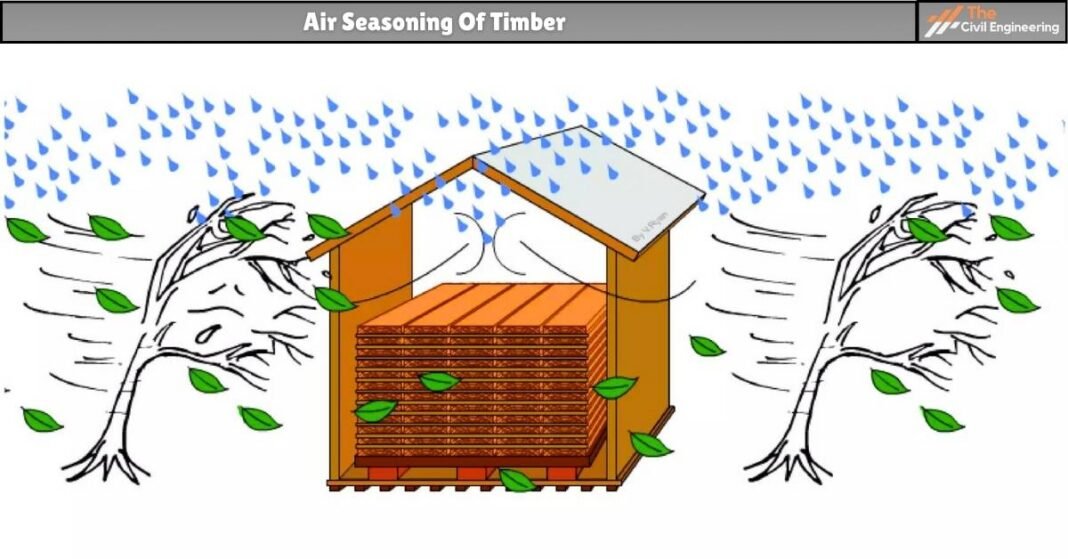1. Introduction
Timber is an important construction material used widely for various engineering purposes. A sound and durable timber is a must for ensuring the structural stability and performance of the structure being constructed. One of the methods of developing the strength and durability of timber is the seasoning of timber. We will discuss the 4 types of timber seasoning.
Timber Seasoning can be simply defined as the process of reducing the moisture content of timber under controlled conditions.
Generally, when a tree has been freshly felled, it contains a considerable amount of sap. Sap refers to the fluid consisting of mainly sugar and mineral salts that flows through the vascular system of the plant.

If this sap is not removed, the timber becomes prone to defects like warping, cracking, shrinkage and decaying.
Thus, seasoning of timber is necessary to remove the undesirable sap leaving behind uniformly distributed moisture throughout the mass of timber.
A well-seasoned timber contains only about 15% of moisture content.
The primary objective of timber seasoning is to reduce the moisture content and also to reduce the unnecessary weight of timber thereby increasing the durability and life span of timber.
2. Objectives of Timber Seasoning
The main objectives of timber seasoning can be listed as follows:
1. It reduces the possibility of fungi and insect attacks.
2. It increases the resistance to shrinkage, cracking, warping and even decay.
3. Timber becomes lightweight after seasoning. Thus, the handling of timber becomes easier.
4. The timber becomes more workable upon seasoning. It becomes easy to polish and paint the seasoned timber.
5. A well-seasoned timber can also be efficiently treated with preservatives.
6. It increases the strength and stability of the timber.
7. A well-seasoned timber also offers better electrical resistance.
3. Types of Timber Seasoning
The methods of seasoning of timber can be categorized as a natural method of seasoning and artificial method of seasoning.
They are further described below:
I. Natural Method
The natural method of seasoning is carried out with the aid of natural factors mainly air and water. It may be further classified into the following:
a. Water Seasoning
This is the natural method of seasoning in which the timber is immersed in water to remove the sap of timber.
Such type of seasoning takes about 2 to 4 weeks for completion.

b. Air Seasoning
Air seasoning is the type of natural seasoning in which the moisture content of timber is reduced by the aid of air circulation.
In this method of seasoning, the logs of timber are stacked in order, under a shed.
The arrangement is such that a certain gap is maintained with the ground.
The platform where the stacking is done is generally kept 300mm above the ground surface.
It is ensured that air is circulated freely in the logs of the timber.
The circulation of air results in the reduction of moisture content of timber.
The progress of this method of seasoning is relatively low. However, it is an efficient method of seasoning.

II. Artificial Method
The artificial method of seasoning timber is accomplished under controlled conditions. These methods are relatively faster than the conventional natural methods of seasoning. Due to this reason, the artificial method of seasoning is widely used.
The complete seasoning of timber can be attained in average 4-5 days using this method of seasoning.
Artificial method of seasoning can be further classified into the following types:
a. Chemical Seasoning
As the name itself implies, this method employs chemicals for the seasoning of timber.
Chemical seasoning includes storage of timber in a suitable salt solution for a certain period. The salt solution used is such that it is capable of absorbing water from the timber. After sufficient immersion, the timber is removed and left for drying.
The common chemicals used for the purpose include urea, carbon dioxide, ammonium carbonate, etc.
Chemical seasoning takes about 30 to 40 days for completion.
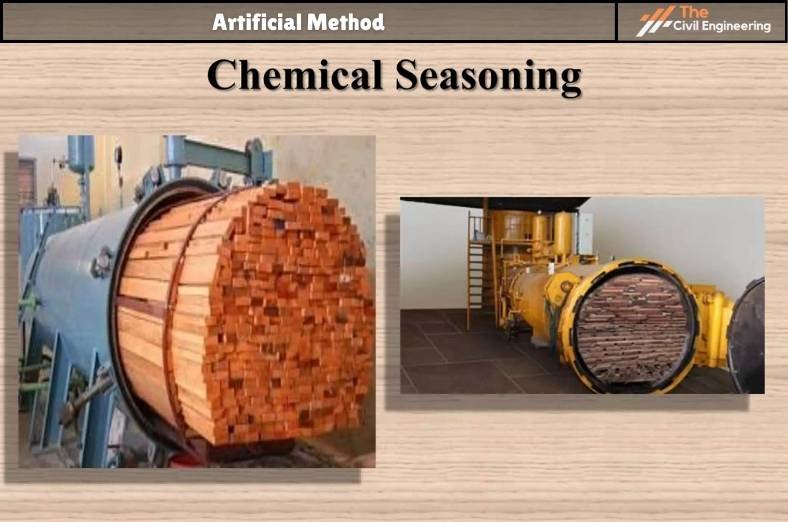
b. Seasoning by Boiling
Seasoning of timber by boiling is a very fast method of artificial seasoning.
It can be accomplished within 3 to 4 hours.
In this method, the boiling of timber is done followed by the drying of timber.
Since it is not practical to boil a large stack of timber so commonly passing of very hot steam through the logs of timber in an enclosed space is done.
This method is efficient for producing well-seasoned timber but it is comparatively costlier.
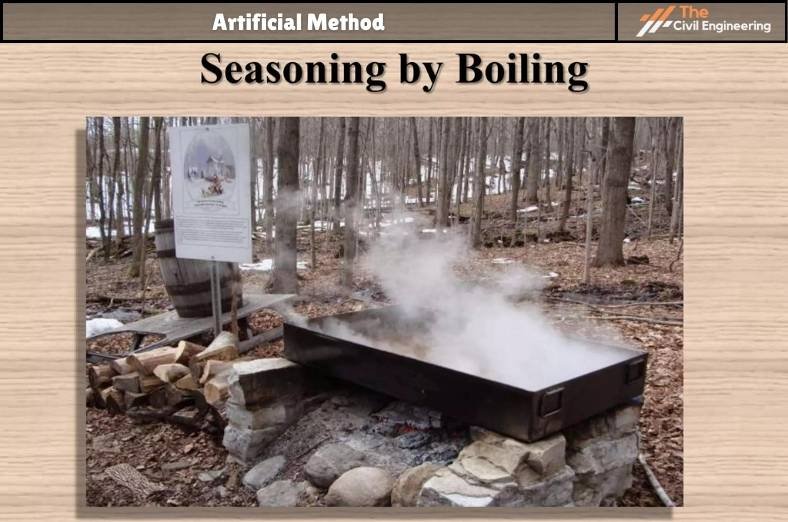
c. Kiln Seasoning
Kiln seasoning is an artificial method of seasoning which is accomplished by the passage of hot air in the logs of timber stacked in an airtight chamber.
The circulation of hot air facilitates the reduction of moisture content.
In this method, the timber logs are first stacked in a chamber. Then, the temperature inside the chamber is increased with the help of heating coils.
As the temperature increases, the sap present in the timber is reduced thereby seasoning the timber.
It produces well-seasoned and strong timber.
It is a widely used method of artificial seasoning because of its high efficiency. However, it is a relatively expensive method of seasoning.
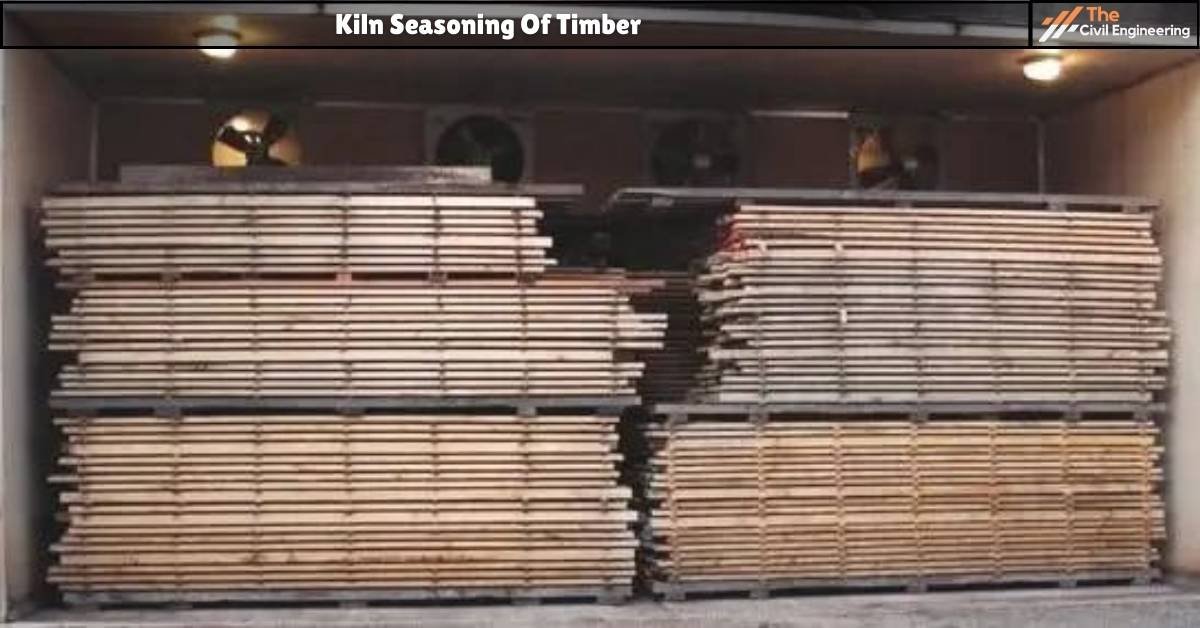
fig: Kiln Seasoning
d. Electrical Seasoning
Electrical seasoning is the type of artificial seasoning in which electricity is used for reducing the moisture content.
In this method of seasoning, the logs of timber are subjected to the high frequency of alternating currents. Field electrodes are used to convert the high voltage current to heat.
After subsequent heating, the timber logs are allowed to cool down. Thus, the seasoning of timber is accomplished.
This is a very rapid method of seasoning and is completed within a short period of only 5 to 8 hours.
This method also ensures the uniform seasoning of the timbers.
Electrical seasoning requires a high capital cost.
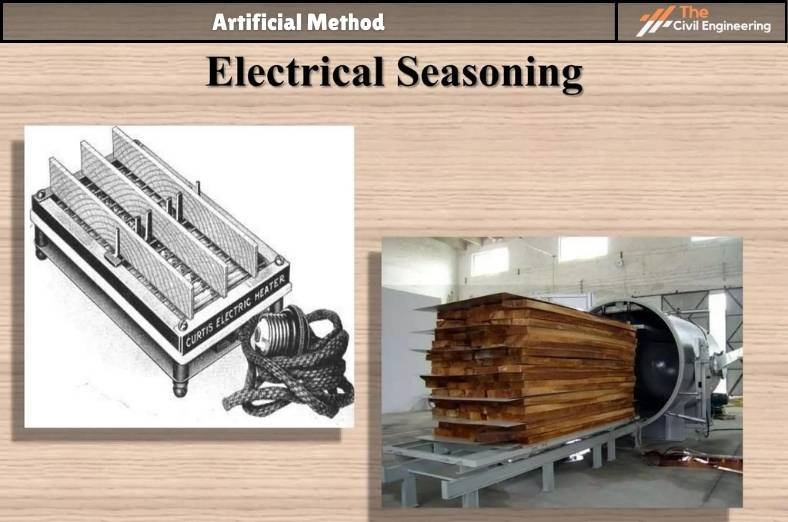
4. Difference Between Air Seasoning & Kiln Seasoning
| Air seasoning | Kiln seasoning |
| 1. It is a slow process. | 1. It is a quick process. |
| 2. It is a simple and cost-effective ( cheaper method). | 2. It is complex and less cost-effective. |
| 3. Air seasoned timbers are more resistive towards fungal and insects attack. | 3. Kiln seasoned timbers are less resistant to the attack of insects and fungi. |
| 4. Requirement of more stacking space. | 4. Requirement of less stacking space. |
| 5. Thus obtained timbers are relatively stronger. | 5. Thus obtained timbers are relatively weaker than air seasoned one. |
| Read Also: Tacheometric Surveying |
